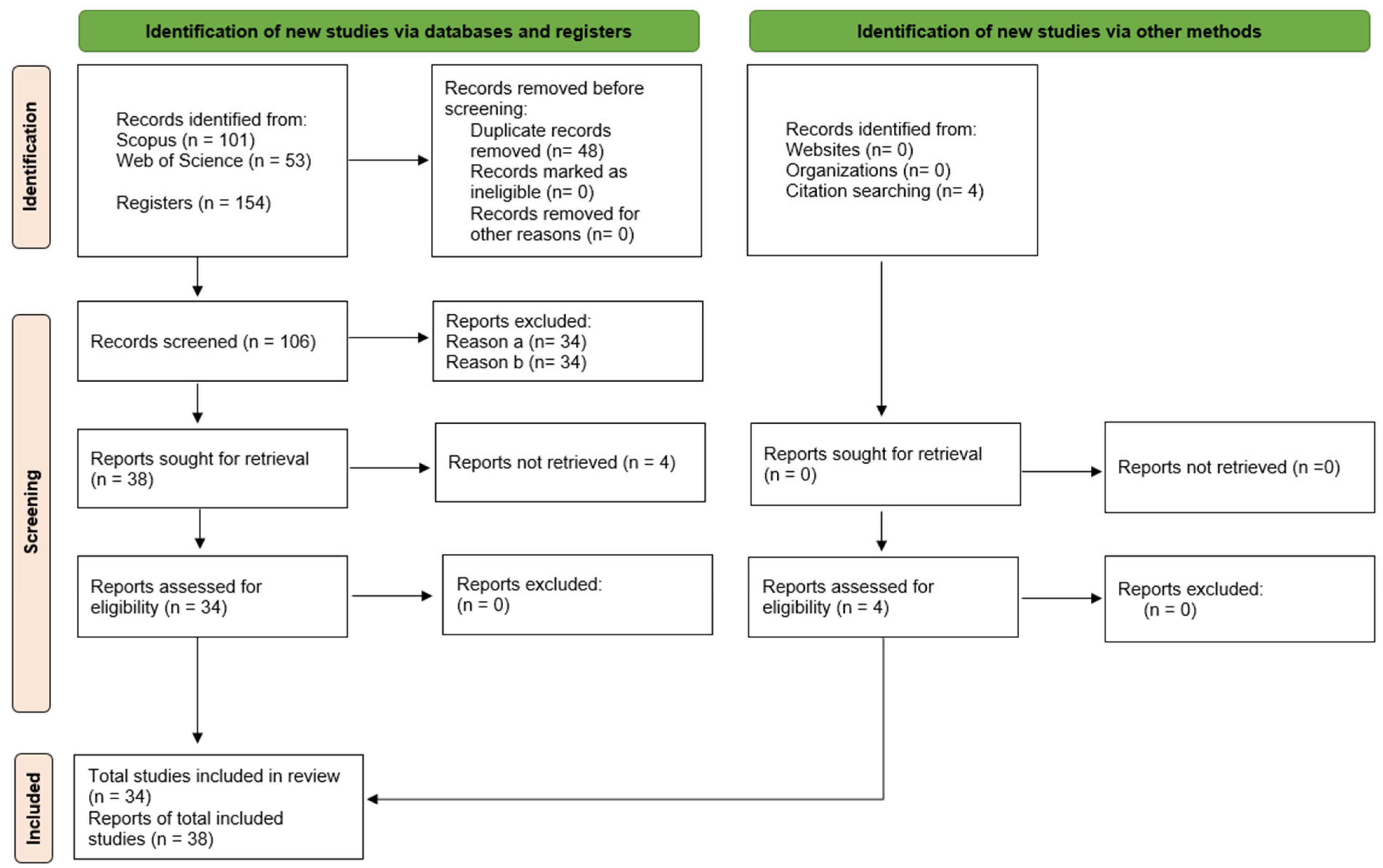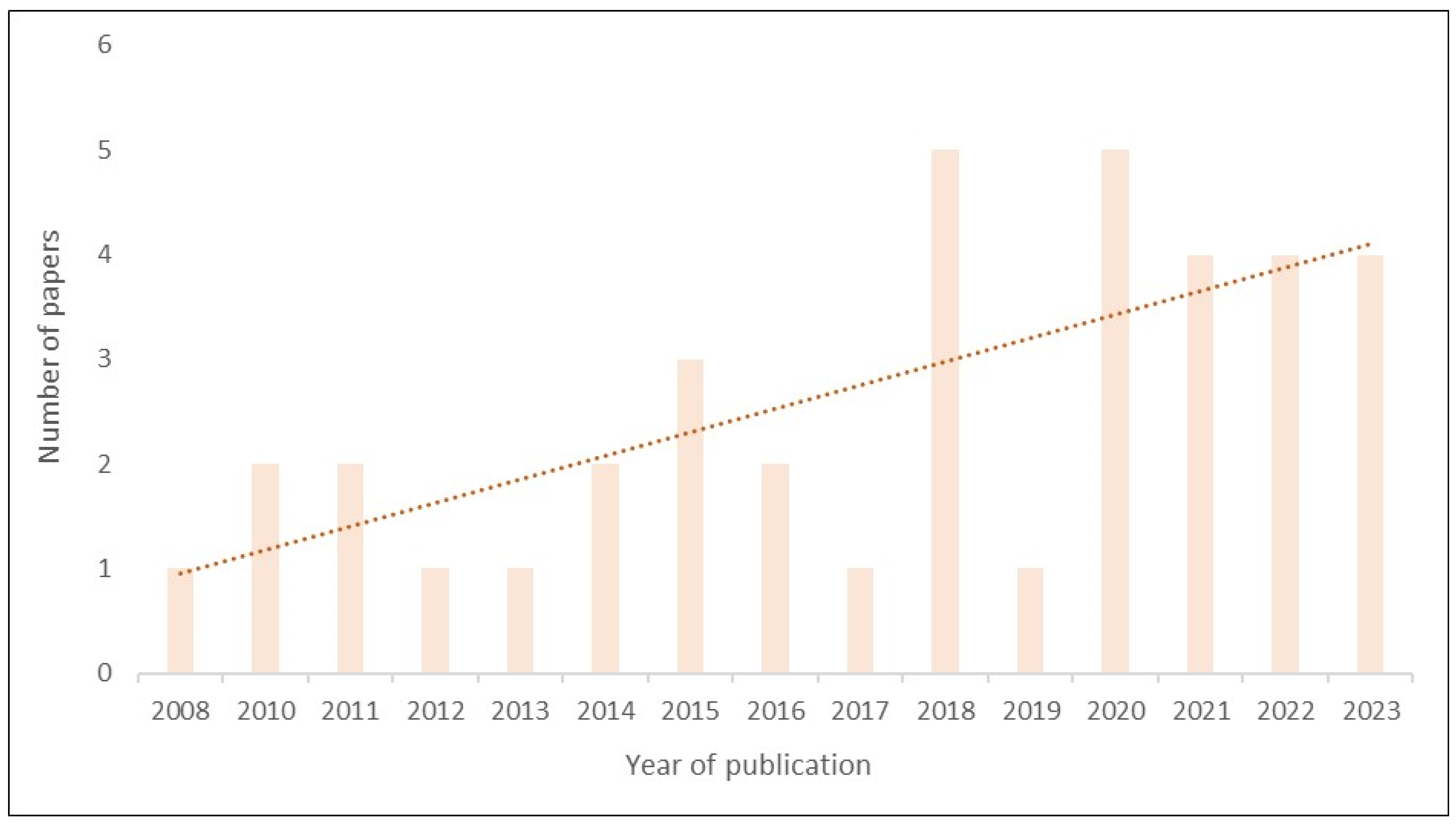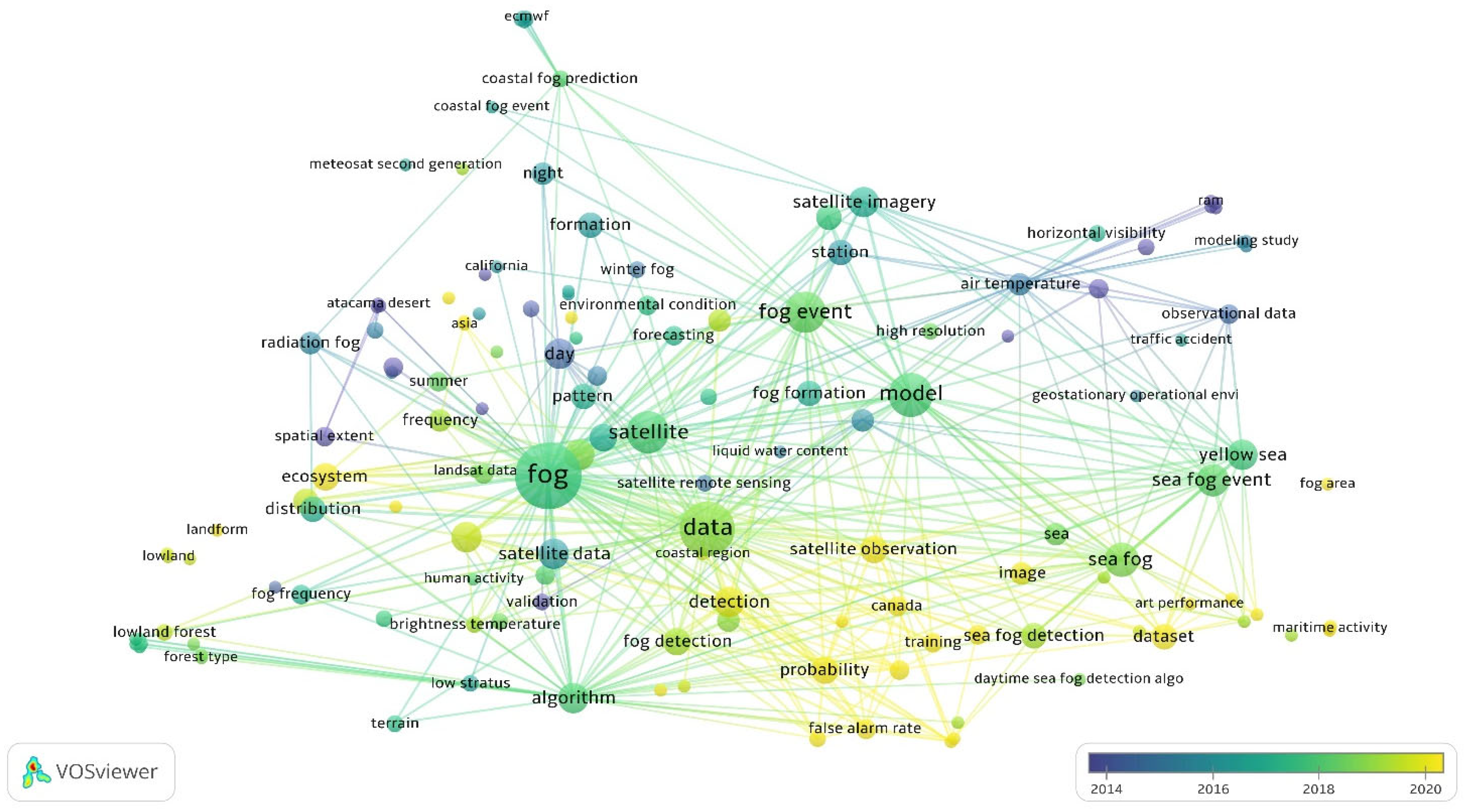From Climate to Cloud: Advancing Fog Detection Through Satellite Imagery
Abstract
1. Introduction
2. Material and Methods
Literature Review and Data Extraction
3. Results and Discussion
3.1. Analysis of Publications
3.2. Term Co-Occurrence Analysis
3.3. Satellite Data in Fog Detection
3.4. Methodologies for Fog Detection
4. Conclusions
Supplementary Materials
Author Contributions
Funding
Data Availability Statement
Conflicts of Interest
References
- World Meteorological Organization. International Meteorological Vocabulary; World Meteorological Organization: Geneva, Switzerland, 1992; Volume 182. [Google Scholar]
- Bruijnzeel, L.A.; Mulligan, M.; Scatena, F.N. Hydrometeorology of Tropical Montane Cloud Forests: Emerging Patterns. Hydrol. Process. 2011, 25, 465–498. [Google Scholar] [CrossRef]
- Gultepe, I.; Tardif, R.; Michaelides, S.C.; Cermak, J.; Bott, A.; Bendix, J.; Müller, M.D.; Pagowski, M.; Hansen, B.; Ellrod, G.; et al. Fog Research: A Review of Past Achievements and Future Perspectives. Pure Appl. Geophys. 2007, 164, 1121–1159. [Google Scholar] [CrossRef]
- Gultepe, I.; Sharman, R.; Williams, P.D.; Zhou, B.; Ellrod, G.; Minnis, P.; Trier, S.; Griffin, S.; Yum, S.S.; Gharabaghi, B.; et al. A Review of High Impact Weather for Aviation Meteorology. Pure Appl. Geophys. 2019, 176, 1869–1921. [Google Scholar] [CrossRef]
- Hameed, S.; Mirza, M.I.; Ghauri, B.M.; Siddiqui, Z.R.; Javed, R.; Khan, A.R.; Rattigan, O.V.; Qureshi, S.; Husain, L. On the Widespread Winter Fog in Northeastern Pakistan and India. Geophys. Res. Lett. 2000, 27, 1891–1894. [Google Scholar] [CrossRef]
- Gupta, S.K.; Elumalai, S.P. Adverse Impacts of Fog Events during Winter on Fine Particulate Matter, CO and VOCs: A Case Study of a Highway near Dhanbad, India. Weather 2018, 73, 396–402. [Google Scholar] [CrossRef]
- Martin, A.E. Mortality and Morbidity Statistics and Air Pollution. R. Soc. Med. 1964, 57, 969–975. [Google Scholar] [CrossRef] [PubMed]
- Holder, C.D. Fog Precipitation in the Sierra de Las Minas Biosphere Reserve, Guatemala. Hydrol. Process. 2003, 17, 2001–2010. [Google Scholar] [CrossRef]
- Bruijnzeel, L.S.; Eugster, W.; Burkard, R. Fog as a Hydrologic Input. In Encyclopedia of Hydrological Sciences; Anderson, M.G., Ed.; John Wiley & Sons, Ltd.: Hoboken, NJ, USA, 2005. [Google Scholar]
- Bruijnzeel, L.A.; Scatena, F.N.; Hamilton, L.S. Tropical Montane Cloud Forests: Science for Conservation and Management; Cambridge University Press: Cambridge, UK, 2011; ISBN 9780511778384. [Google Scholar]
- García-Santos, G.; Bruijnzeel, L.A. Rainfall, Fog and Throughfall Dynamics in a Subtropical Ridge Top Cloud Forest, National Park of Garajonay (La Gomera, Canary Islands, Spain). Hydrol. Process. 2011, 25, 411–417. [Google Scholar] [CrossRef]
- Amani, M.; Mahdavi, S.; Bullock, T.; Beale, S. Automatic Nighttime Sea Fog Detection Using GOES-16 Imagery. Atmos. Res. 2020, 238, 104712. [Google Scholar] [CrossRef]
- Baguskas, S.A.; Clemesha, R.E.S.; Loik, M.E. Coastal Low Cloudiness and Fog Enhance Crop Water Use Efficiency in a California Agricultural System. Agric. For. Meteorol. 2018, 252, 109–120. [Google Scholar] [CrossRef]
- Yuan, Y.; Qiu, Z.; Sun, D.; Wang, S.; Yue, X. Daytime Sea Fog Retrieval Based on GOCI Data: A Case Study over the Yellow Sea. Opt. Express 2016, 24, 787. [Google Scholar] [CrossRef] [PubMed]
- Wu, D.; Lu, B.; Zhang, T.; Yan, F. A Method of Detecting Sea Fogs Using CALIOP Data and Its Application to Improve MODIS-Based Sea Fog Detection. J. Quant. Spectrosc. Radiat. Transf. 2015, 153, 88–94. [Google Scholar] [CrossRef]
- Zhang, S.; Yi, L. A Comprehensive Dynamic Threshold Algorithm for Daytime Sea Fog Retrieval over the Chinese Adjacent Seas. Pure Appl. Geophys. 2013, 170, 1931–1944. [Google Scholar] [CrossRef]
- Bari, D.; Bergot, T.; El Khlifi, M. Numerical Study of a Coastal Fog Event over Casablanca, Morocco. Q. J. R. Meteorol. Soc. 2015, 141, 1894–1905. [Google Scholar] [CrossRef]
- Obregon, A.; Gehrig-Downie, C.; Gradstein, S.R.; Bendix, J. The Potential Distribution of Tropical Lowland Cloud Forest as Revealed by a Novel MODIS-Based Fog/Low Stratus Night-Time Detection Scheme. Remote Sens. Environ. 2014, 155, 312–324. [Google Scholar] [CrossRef]
- Lehnert, L.W.; Thies, B.; Trachte, K.; Achilles, S.; Osses, P.; Baumann, K.; Schmidt, J.; Samolov, E.; Jung, P.; Leinweber, P.; et al. A Case Study on Fog/Low Stratus Occurrence at Las Lomitas, Atacama Desert (Chile) as a Water Source for Biological Soil Crusts. Aerosol Air Qual. Res. 2018, 18, 254–269. [Google Scholar] [CrossRef]
- Andersen, H.; Cermak, J.; Fuchs, J.; Knippertz, P.; Gaetani, M.; Quinting, J.; Sippel, S.; Vogt, R. Synoptic-Scale Controls of Fog and Low-Cloud Variability in the Namib Desert. Atmos. Chem. Phys. 2020, 20, 3415–3438. [Google Scholar] [CrossRef]
- Parde, A.N.; Ghude, S.D.; Dhangar, N.G.; Bhautmage, U.P.; Wagh, S.; Lonkar, P.; Govardhan, G.; Kumar, R.; Biswas, M.; Chen, F. Challenges in Simulating Prevailing Fog Types Over Urban Region of Delhi. J. Geophys. Res. Atmos. 2024, 129, e2023JD039772. [Google Scholar] [CrossRef]
- Hunt, G.E. Radiative Properties of Terrestrial Clouds at Visible and Infra-red Thermal Window Wavelengths. Q. J. R. Meteorol. Soc. 1973, 99, 346–369. [Google Scholar] [CrossRef]
- Eyre, J.R.; Brownscombe, J.L.; Allam, R.J. Detection of Fog at Night Using Advanced Very High Resolution Radiometer (AVHRR) Imagery. Meteorol. Mag. 1984, 113, 266–271. [Google Scholar]
- Turner, J.; Allam, R.J.; Maine, D.R. AA Case Study of the Detection of Fog at Night Using Channel 3 and 4 on the Advanced Very High Resolution Radiometer (AVHRR). Meteorol. Mag. 1986, 115, 285–290. [Google Scholar]
- Bendix, J. A Case Study on the Determination of Fog Optical Depth and Liquid Water Path Using AVHRR Data and Relations to Fog Liquid Water Content and Horizontal Visibility. Int. J. Remote Sens. 1995, 16, 515–530. [Google Scholar] [CrossRef]
- Bendix, J.; Bachmann, M. A Method for Detection of Fog Using AVHRR-Imagery of NOAA Satellites Suitable for Operational Purposes. Meteorol. Rundsch. 1991, 43, 169–178. [Google Scholar]
- Ellrod, G. Advances in the Detection and Analysis of Fog at Night Using GOES Multispectral Infrared Imagery. Weather. Forecast. 1995, 4, 606–619. [Google Scholar] [CrossRef]
- Wetzel, M.A.; Borys, R.D.; Xu, L.E. Satellite Microphysical Retrievals for Land-Based Fog with Validation by Balloon Profiling. J. Appl. Meteorol. 1996, 5, 810–829. [Google Scholar] [CrossRef]
- Greenwald, T.J.; Christopher, S.A. The GOES I-M Imagers: New Tools for Studying Microphysical Properties of Boundary Layer Stratiform Clouds. Bull. Am. Meteorol. Soc. 2000, 81, 2607–2620. [Google Scholar] [CrossRef]
- Bendix, J.; Thies, B.; Cermak, J.; Nauß, T. Ground Fog Detection from Space Based on MODIS Daytime Data-A Feasibility Study. Am. Meteorol. Soc. 2005, 20, 989–1005. [Google Scholar] [CrossRef]
- Bendix, J. A Satellite-Based Climatology of Fog and Low-Level Stratus in Germany and Adjacent Areas. Atmos. Res. 2002, 64, 3–18. [Google Scholar] [CrossRef]
- Page, M.J.; McKenzie, J.E.; Bossuyt, P.M.; Boutron, I.; Hoffmann, T.C.; Mulrow, C.D.; Shamseer, L.; Tetzlaff, J.M.; Akl, E.A.; Brennan, S.E.; et al. The PRISMA 2020 Statement: An Updated Guideline for Reporting Systematic Reviews. BMJ 2021, 372, n71. [Google Scholar]
- Pranckutė, R. Web of Science (WoS) and Scopus: The Titans of Bibliographic Information in Today’s Academic World. Publications 2021, 9, 12. [Google Scholar] [CrossRef]
- van Eck, J.N.; Waltman, L. Manual for VOSviewer, Version 1.6.20; 2023. Available online: https://www.vosviewer.com/documentation/Manual_VOSviewer_1.6.20.pdf (accessed on 13 January 2024).
- Fu, D.; Wang, S.; Chen, D.; Pang, H.; Li, P. Comparison Study between Observation and Simulation for Sea Fog over the Yellow Sea in May 2009. J. Ocean Univ. China 2012, 11, 290–300. [Google Scholar] [CrossRef]
- Fu, G.; Li, P.; Crompton, J.G.; Guo, J.; Gao, S.; Zhang, S. An Observational and Modeling Study of a Sea Fog Event over the Yellow Sea on 1 August 2003. Meteorol. Atmos. Phys. 2010, 107, 149–159. [Google Scholar] [CrossRef]
- Guo, Y.; Xu, T.; Cheng, J.; Wei, G.; Lin, Y. Above- and Belowground Biodiversity Drives Soil Multifunctionality along a Long-Term Grassland Restoration Chronosequence. Sci. Total Environ. 2021, 772, 145010. [Google Scholar] [CrossRef]
- Lu, H.; Ma, Y.; Zhang, S.; Yu, X.; Zhang, J. Daytime Sea Fog Identification Based on Multi-Satellite Information and the ECA-TransUnet Model. Remote Sens. 2023, 15, 3949. [Google Scholar] [CrossRef]
- Ran, Y.; Ma, H.; Liu, Z.; Wu, X.; Li, Y.; Feng, H. Satellite Fog Detection at Dawn and Dusk Based on the Deep Learning Algorithm under Terrain-Restriction. Remote Sens. 2022, 14, 4328. [Google Scholar] [CrossRef]
- Yan, H.; Su, S.; Wu, M.; Xu, M.; Zuo, Y.; Zhang, C.; Huang, B. SeaMAE: Masked Pre-Training with Meteorological Satellite Imagery for Sea Fog Detection. Remote Sens. 2023, 15, 4102. [Google Scholar] [CrossRef]
- Zhou, Y.; Chen, K.; Li, X. Dual-Branch Neural Network for Sea Fog Detection in Geostationary Ocean Color Imager. IEEE Trans. Geosci. Remote Sens. 2022, 60, 4208617. [Google Scholar] [CrossRef]
- Chen, C.; Zhang, M.; Perrie, W.; Chang, R.; Chen, X.; Duplessis, P.; Wheeler, M. Boundary Layer Parameterizations to Simulate Fog Over Atlantic Canada Waters. Earth Space Sci. 2020, 7, 2019EA000703. [Google Scholar] [CrossRef]
- Mahdavi, S.; Amani, M.; Bullock, T.; Beale, S. A Probability-Based Daytime Algorithm for Sea Fog Detection Using GOES-16 Imagery. IEEE J. Sel. Top. Appl. Earth Obs. Remote Sens. 2021, 14, 1363–1373. [Google Scholar] [CrossRef]
- Gultepe, I.; Pardyjak, E.; Hoch, S.W.; Fernando, H.J.S.; Dorman, C.; Flagg, D.D.; Krishnamurthy, R.; Wang, Q.; Gaberšek, S.; Creegan, E.; et al. Coastal-Fog Microphysics Using In-Situ Observations and GOES-R Retrievals. Boundary Layer. Meteorol. 2021, 181, 203–226. [Google Scholar] [CrossRef]
- Ahmed, R.; Dey, S.; Mohan, M. A Study to Improve Night Time Fog Detection in the Indo-Gangetic Basin Using Satellite Data and to Investigate the Connection to Aerosols. Meteorol. Appl. 2015, 22, 689–693. [Google Scholar] [CrossRef]
- Banerjee, S.; Padmakumari, B. Spatiotemporal Variability and Evolution of Day and Night Winter Fog over the Indo Gangetic Basin Using INSAT-3D and Comparison with Surface Visibility and Aerosol Optical Depth. Sci. Total Environ. 2020, 745, 140962. [Google Scholar] [CrossRef] [PubMed]
- Saraf, A.K.; Bora, A.K.; Das, J.; Rawat, V.; Sharma, K.; Jain, S.K. Winter Fog over the Indo-Gangetic Plains: Mapping and Modelling Using Remote Sensing and GIS. Nat. Hazards 2011, 58, 199–220. [Google Scholar] [CrossRef]
- Singh, M.K.; Gautam, R. Developing a Long-Term High-Resolution Winter Fog Climatology over South Asia Using Satellite Observations from 2002 to 2020. Remote Sens. Environ. 2022, 279, 113128. [Google Scholar] [CrossRef]
- Gautam, R.; Singh, M.K. Urban Heat Island Over Delhi Punches Holes in Widespread Fog in the Indo-Gangetic Plains. Geophys. Res. Lett. 2018, 45, 1114–1121. [Google Scholar] [CrossRef]
- Cereceda, P.; Larrain, H.; Osses, P.; Farías, M.; Egaña, I. The Spatial and Temporal Variability of Fog and Its Relation to Fog Oases in the Atacama Desert, Chile. Atmos. Res. 2008, 87, 312–323. [Google Scholar] [CrossRef]
- Bari, D.; Bergot, T. Influence of Environmental Conditions on Forecasting of an Advection-Radiation Fog: A Case Study from the Casablanca Region, Morocco. Aerosol Air Qual. Res. 2018, 18, 62–78. [Google Scholar] [CrossRef]
- Baldocchi, D.; Waller, E. Winter Fog Is Decreasing in the Fruit Growing Region of the Central Valley of California. Geophys. Res. Lett. 2014, 41, 3251–3256. [Google Scholar] [CrossRef]
- Haensler, A.; Cermak, J.; Hagemann, S.; Jacob, D. Will the Southern African West Coast Fog Be Affected by Future Climate Change?: Results of an Initial Fog Projection Using a Regional Climate Model. Erdkunde 2011, 65, 261–275. [Google Scholar] [CrossRef]
- Pohl, M.J.; Lehnert, L.; Bader, M.Y.; Gradstein, S.R.; Viehweger, J.; Bendix, J. A New Fog and Low Stratus Retrieval for Tropical South America Reveals Widespread Fog in Lowland Forests. Remote Sens. Environ. 2021, 264, 112620. [Google Scholar] [CrossRef]
- Pohl, M.J.; Lehnert, L.W.; Thies, B.; Seeger, K.; Berdugo, M.B.; Gradstein, S.R.; Bader, M.Y.; Bendix, J. Valleys Are a Potential Refuge for the Amazon Lowland Forest in the Face of Increased Risk of Drought. Commun. Earth Environ. 2023, 4, 198. [Google Scholar] [CrossRef]
- Schulz, H.M.; Thies, B.; Chang, S.C.; Bendix, J. Detection of Ground Fog in Mountainous Areas from MODIS (Collection 051) Daytime Data Using a Statistical Approach. Atmos. Meas. Tech. 2016, 9, 1135–1152. [Google Scholar] [CrossRef]
- Schulz, H.M.; Li, C.F.; Thies, B.; Chang, S.C.; Bendix, J. Mapping the Montane Cloud Forest of Taiwan Using 12 Year MODIS-Derived Ground Fog Frequency Data. PLoS ONE 2017, 12, E0172663. [Google Scholar] [CrossRef]
- Garland, R.M.; Altieri, K.E.; Dawidowski, L.; Gallardo, L.; Mbandi, A.; Rojas, N.Y.; Touré, N.E. Opinion: Strengthening Research in the Global South—Atmospheric Science Opportunities in South America and Africa. Atmos. Chem. Phys. 2024, 24, 5757–5764. [Google Scholar] [CrossRef]
- Yi, L.; Li, K.F.; Chen, X.; Tung, K.K. Arctic Fog Detection Using Infrared Spectral Measurements. J. Atmos. Ocean. Technol. 2019, 36, 1643–1656. [Google Scholar] [CrossRef]
- Wang, J.L.; Li, S.M.; Liu, X.L.; Wu, X.J. An Analysis of the Fog Distribution in Beijing for the 2001-2005 Period Using NOAA and FY Data. Atmos. Res. 2010, 96, 575–589. [Google Scholar] [CrossRef]
- Guo, J.; Xu, J.; Xu, X. An Observational and Modeling Study of a Sea Fog Event over the Yellow and East China Seas on 17 March 2014. Trop. Cyclone Res. Rev. 2021, 10, 182–190. [Google Scholar] [CrossRef]
- Kim, Y.; Ryu, H.S.; Hong, S. Data-to-Data Translation-Based Nowcasting of Specific Sea Fog Using Geostationary Weather Satellite Observation. Atmos. Res. 2023, 290, 106792. [Google Scholar] [CrossRef]
- Ball, L.; Tzanopoulos, J. Interplay between Topography, Fog and Vegetation in the Central South Arabian Mountains Revealed Using a Novel Landsat Fog Detection Technique. Remote Sens. Ecol. Conserv. 2020, 6, 498–513. [Google Scholar] [CrossRef]
- Li, H.J.; Lo, M.H.; Juang, J.Y.; Wang, J.; Huang, C. Assessment of Spatiotemporal Dynamics of Diurnal Fog Occurrence in Subtropical Montane Cloud Forests. Agric. For. Meteorol. 2022, 317, 108899. [Google Scholar] [CrossRef]
- Egli, S.; Thies, B.; Bendix, J. A Hybrid Approach for Fog Retrieval Based on a Combination of Satellite and Ground Truth Data. Remote Sens. 2018, 10, 628. [Google Scholar] [CrossRef]






| Database | Keywords |
|---|---|
| Scopus: | TITLE-ABS-KEY (“fog water” OR “fog interception” OR “fog characteristic” OR “fog intensity” OR “fog event” OR “fog occurrence” OR “fog formation” OR “fog frequency”) AND TITLE-ABS-KEY (“remote sensing” OR “satellite imagery” OR “remote-sensing” OR “hyperspectral” OR “GIS” OR “image enhancement” OR “remote sensing images”) AND (LIMIT-TO (DOCTYPE, “ar”)) |
| Web of Science: | (TS = (“fog water” OR “fog interception” OR “fog characteristic” OR “fog intensity” OR “fog event” OR “fog occurrence” OR “fog formation” OR “fog frequency”)) AND (TS = (“remote sensing” OR “satellite imagery” OR “remote-sensing” OR “hyperspectral” OR “GIS” OR “image enhancement” OR “remote sensing images”)) AND (DT = (“ARTICLE”)) |
Disclaimer/Publisher’s Note: The statements, opinions and data contained in all publications are solely those of the individual author(s) and contributor(s) and not of MDPI and/or the editor(s). MDPI and/or the editor(s) disclaim responsibility for any injury to people or property resulting from any ideas, methods, instructions or products referred to in the content. |
© 2025 by the authors. Licensee MDPI, Basel, Switzerland. This article is an open access article distributed under the terms and conditions of the Creative Commons Attribution (CC BY) license (https://creativecommons.org/licenses/by/4.0/).
Share and Cite
Chaverri, A.G.A.; Toppa, R.H.; Tonello, K.C. From Climate to Cloud: Advancing Fog Detection Through Satellite Imagery. Climate 2025, 13, 110. https://doi.org/10.3390/cli13060110
Chaverri AGA, Toppa RH, Tonello KC. From Climate to Cloud: Advancing Fog Detection Through Satellite Imagery. Climate. 2025; 13(6):110. https://doi.org/10.3390/cli13060110
Chicago/Turabian StyleChaverri, Andrés Gabriel Arguedas, Rogério Hartung Toppa, and Kelly Cristina Tonello. 2025. "From Climate to Cloud: Advancing Fog Detection Through Satellite Imagery" Climate 13, no. 6: 110. https://doi.org/10.3390/cli13060110
APA StyleChaverri, A. G. A., Toppa, R. H., & Tonello, K. C. (2025). From Climate to Cloud: Advancing Fog Detection Through Satellite Imagery. Climate, 13(6), 110. https://doi.org/10.3390/cli13060110








